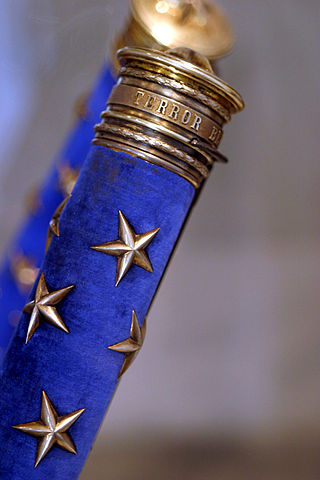
The Hôtel des Invalides, commonly called Les Invalides, is a complex of buildings in the 7th arrondissement of Paris, France, containing museums and monuments, all relating to the military history of France, as well as a hospital and an Old Soldiers' retirement home, the building's original purpose. The buildings house the Musée de l'Armée, the military museum of the Army of France, the Musée des Plans-Reliefs, and the Musée d'Histoire Contemporaine. The complex also includes the former hospital chapel, now national cathedral of the French military, and the adjacent former Royal Chapel known as the Dôme des Invalides, the tallest church building in Paris at a height of 107 meters. The latter has been converted into a shrine of some of France's leading military figures, most notably the tomb of Napoleon.

Marshal of France is a French military distinction, rather than a military rank, that is awarded to generals for exceptional achievements. The title has been awarded since 1185, though briefly abolished (1793–1804) and for a period dormant (1870–1916). It was one of the Great Officers of the Crown of France during the Ancien Régime and Bourbon Restoration, and one of the Grand Dignitaries of the Empire during the First French Empire.
Events from the year 1963 in France.
Events from the year 1962 in France.
Events from the year 1844 in France.
Events from the year 1843 in France.
Events from the year 1808 in France.
Events from the year 1832 in France.
Events from the year 1811 in France.
Events from the year 1798 in France.
Events from the year 1807 in France.
Events from the year 1815 in France.
Events from the year 1796 in France.
Events from the year 1802 in France.
Events from the year 1803 in France.
Events from the year 1810 in France.
Events from the year 1814 in France.
Events from the year 1800 in France.
The Commission des Sciences et des Arts was a French scientific and artistic institute. Established on 16 March 1798, it consisted of 167 members, of which all but 16 joined Napoleon Bonaparte's campaign in Egypt and produced the Description de l'Égypte. More than half were engineers and technicians, including 21 mathematicians, 3 astronomers, 17 civil engineers, 13 naturalists and mining engineers, geographers, 3 gunpowder engineers, 4 architects, 8 artists, 10 mechanical artists, 1 sculptor, 15 interpreters, 10 men of letters, 22 printers in Latin, Greek and Arabic characters. Bonaparte organised his scientific 'corps' like an army, dividing its members into 5 categories and assigning to each member a military rank and a defined military role beyond his scientific function.

François Clary was a wealthy Irish-French merchant and is an ancestor of many European monarchs by two of his daughters. He was the father of Julie Clary, Queen of Naples and of Spain and the Indies by marriage to Joseph Bonaparte, a brother of Napoleon Bonaparte. He was also the father of Désirée Clary, who was first engaged to Napoleon and later became Queen of Sweden and Norway by marriage to King Charles XIV John.



